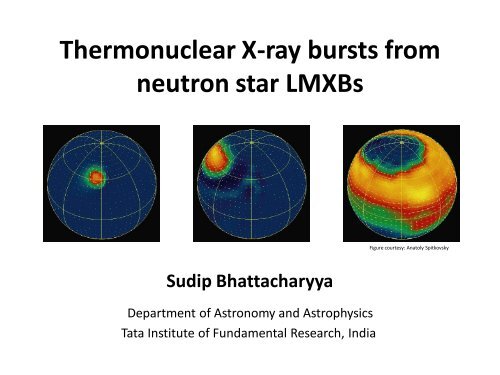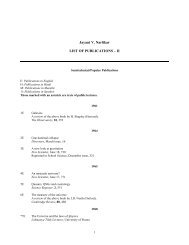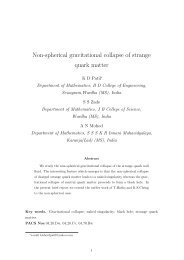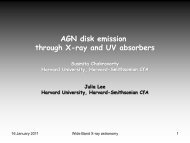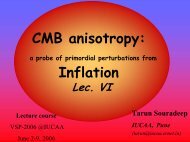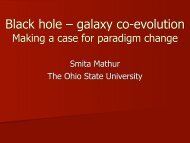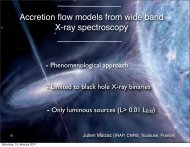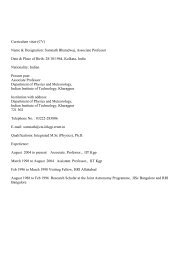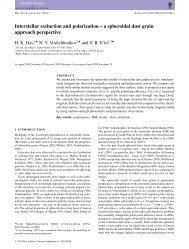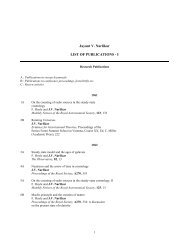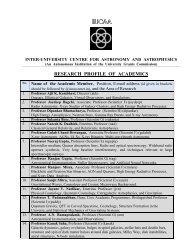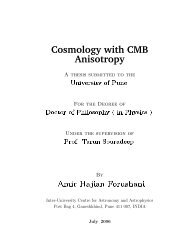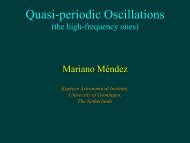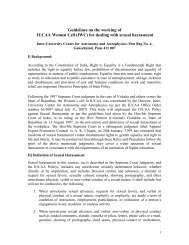Thermonuclear X-ray bursts from neutron star LMXBs - iucaa
Thermonuclear X-ray bursts from neutron star LMXBs - iucaa
Thermonuclear X-ray bursts from neutron star LMXBs - iucaa
You also want an ePaper? Increase the reach of your titles
YUMPU automatically turns print PDFs into web optimized ePapers that Google loves.
<strong>Thermonuclear</strong> X-<strong>ray</strong> <strong>bursts</strong> <strong>from</strong><strong>neutron</strong> <strong>star</strong> <strong>LMXBs</strong>Figure courtesy: Anatoly SpitkovskySudip BhattacharyyaDepartment of Astronomy and AstrophysicsTata Institute of Fundamental Research, India
IntroductionNeutron StarNeutron <strong>star</strong> vs. a cityRadius ~ 10 - 20 kmMass ~ 1.4 - 2.0 solar massCore density ~ 5 -10 times thenuclear densityMagnetic field ~ 10 7 - 10 15 GFigure courtesy M. Coleman MillerSpin frequency (in some binarystellar systems)~ 300 - 600 HzSome of the most extreme conditions of the universe exist in <strong>neutron</strong><strong>star</strong>s.
IntroductionNeutron Star: Surface and InteriorCore density > nuclear densityExotic matter???No terrestrial experiments seempossible at such high densities andrelatively low temperatures.Figure courtesy D. PageMany equation of state (EoS)models for the <strong>neutron</strong> <strong>star</strong> corematter are available in theliterature. We need to constrainthese models by observing <strong>neutron</strong><strong>star</strong>s.The constituents of <strong>neutron</strong> <strong>star</strong> interiors remain a mystery after 40years.
IntroductionNeutron StarHow to constrain EoS models?Lattimer & Prakash (2001)Mass, radius and spin frequency, or three independent structural parameters of thesame <strong>neutron</strong> <strong>star</strong> are to be measured in order to constrain equation of statemodels.
IntroductionLow-mass X-<strong>ray</strong> Binary (LMXB)Equipotential surfaces in a binary systemCourtesy: Bhattacharya & van den Heuvel (1991)Artist’s impression of a low-mass X-<strong>ray</strong> binaryCourtesy: NASA websiteX-<strong>ray</strong>s <strong>from</strong> inner accretion disk and <strong>neutron</strong> <strong>star</strong> surface.Orbital period: minutes to daysAge ~ Billion yearsChandra image of KS 1731-260Courtesy: NASA websiteNeutron <strong>star</strong> magnetic field ~ 10 7 to 10 9 GNeutron <strong>star</strong> spin ~ 300 to 600 Hz
<strong>Thermonuclear</strong> X-<strong>ray</strong> BurstsParameters which set the ignition condition:(1) chemical composition of accreted matter,(2) temperature (~ 10 8 K),(3) column depth (~ 10 8 gm cm -2 ), and(4) initial conditions set by the previous <strong>bursts</strong>.Various regimes of burning:(1) At T > 10 7 K : Mixed hydrogen and helium burning triggered bythermally unstable hydrogen ignition; hydrogen burns via theCNO cycle.(2) At T > 8 x 10 7 K, hydrogen burns in a stable manner via hotCNO cycle:12C(p,) 13 N(p,) 14 O( + ) 14 N(p,) 15 O( + ) 15 N(p,) 12 C(3) When helium ignition condition is met, and hydrogen is depleted,(happens at a small window of accretion rate) pure helium <strong>bursts</strong>occur (identified by high intensity, short duration and longrecurrence time) : 3 12 C
<strong>Thermonuclear</strong> X-<strong>ray</strong> Bursts(4) At higher accretion rates, hydrogen will be presentduring helium ignition, and mixed hydrogen andhelium burning will happen.High temperature of the helium flashcauses break-out reactions <strong>from</strong> hot CNOcycle: 15 O(,) 19 Ne and 18 Ne(,p) 21 Na.As a result, hydrogen burnsvia the rp process: a series ofsuccessive protoncaptures and decays.rp process: dominant path ofthe nuclei as they move upthe proton-rich side of thevalley of stability (Schatz etal. 2001)(5) At very high accretion rates, the helium burning temperaturesensitivity becomes weaker than cooling rate’s sensitivity. So thestable burning sets in.
Various aspects of <strong>bursts</strong>Continuum Burst Spectroscopy Burst spectra are normally well fitted with a blackbody model. In principle, <strong>neutron</strong> <strong>star</strong> radius can be measured<strong>from</strong> the observed bolometric flux (F obs ) andblackbody temperature (T obs ), and the knownsource distance (d):R obs =d.(F obs /(T 4 obs)) 1/2Burst spectra But there are systematic uncertainties:(1) unknown amount of spectral hardening;(2) effect of unknown gravitational redshift;(3) unknown distance;(4) if part of the surface emits.London, Taam & Howard (1986)Gravitational redshiftT = T obs .(1+z)/f{z > 0; f ~ 1.0 - 2.0R = R obs .f 2 /(1+z) 1+z = [1 - ( 2GM/Rc 2 )] -1/2Atmospheric chemical composition, surface gravity,temperature f (primary problem)
Various aspects of <strong>bursts</strong>Continuum Burst Spectroscopy: problem <strong>from</strong> observationDuring burst rise, thermonuclear flame spreading happens, and the entire <strong>neutron</strong> <strong>star</strong>surface may not emit. But during burst decay, entire <strong>neutron</strong> <strong>star</strong> surface is expected toemit. Therefore, the burning area inferred <strong>from</strong> the continuum spectroscopy shouldremain constant during burst decay, and should be useful to measure the <strong>neutron</strong> <strong>star</strong>radius. But, observationally we find that the inferred burning area can both increaseand decrease apparently erratically. Without understanding this erratic behavior, wecannot hope to measure the <strong>neutron</strong> <strong>star</strong> radius using continuum spectroscopy.First discovery of a pattern in theapparently erratic behavior:R R obs .f 2The correlation may be because of thesystematic variation of the atmosphericchemical composition (and hence the fevolution) between the short and long<strong>bursts</strong>.The correlation is extremely robust.Bhattacharyya, Miller and Galloway (2009)This new pattern will haveimpact on the nuclear physicsand fluid dynamics of <strong>bursts</strong>.It can also significantly reducethe systematics due to unknown f.
Various aspects of <strong>bursts</strong>Fast Timing Properties of X-<strong>ray</strong> Bursts (Burst Oscillations)What are burst oscillations?These are millisecond period variationsof observed intensity during thermonuclearX-<strong>ray</strong> <strong>bursts</strong>.What is their origin?Asymmetric brightness pattern on thespinning <strong>neutron</strong> <strong>star</strong> surfaces.Neutron <strong>star</strong> spin frequency= Burst oscillation frequencyBurst light curveHot spotXTE J1814-338(RXTE-PCA data)Spinning <strong>neutron</strong> <strong>star</strong> Bhattacharyya et al. (2005)The vertical dashed linegives the lower limit of thestellar radius-to-mass ratiowith 90% confidence.
Various aspects of <strong>bursts</strong>Unusually frequent <strong>bursts</strong>Plausible explanations:(1) Successive <strong>bursts</strong> <strong>from</strong> layersof accumulated accretedmatter?(2) Burning temporarily stalled bywaiting points in the chain ofnuclear reactions?Keek et al. (2010)Either of them will be importantfor nuclear physics.These frequent <strong>bursts</strong> are not observed <strong>from</strong> short period binaries.This implies that hydrogen burning processes play a crucial role forthese <strong>bursts</strong>.
Various aspects of <strong>bursts</strong>Long <strong>bursts</strong>The long tail might be dueto the cooling of deeper<strong>neutron</strong> <strong>star</strong> layers,which were heated upthrough inwardconduction of heatproduced by the burst.In’t Zand et al. (2009)
Various aspects of <strong>bursts</strong>Super<strong>bursts</strong>: a challenge for nuclear physicists!Released energy ~ 10 42 ergsRecurrence time ~ yearsDecay time ~ 1-3 hoursStrohmayer and Brown (2001)Believed to be caused by 12 C fusion at acolumn depth of ~10 12 g cm -2Problem: 12 C cannot survive, and should be destroyed by rp process.12C will be converted to 15 O by a part of the hot CNO cycle, and then willpermanently come out of it by the breakout reaction and proton capture:15O(α,) 19 Ne(p,) 20 Na destroying the carbon.Some suggested solutions: (1) CNO abundance in the burning layer is at least fourtimes the solar abundance.(2) Resonance may exist at the astrophysically relevant energy, where the reactioncross section seem to experimentally unknown (entry of nuclearexperimentalists!).
Various aspects of <strong>bursts</strong>Chakraborty and Bhattacharyya, 2011, arXiv:1101.0181Unique <strong>bursts</strong> <strong>from</strong> a Terzan 5 transient NS LMXB:gravitational (type II) or nuclear (type I)?Left: Bursts and non-burst levels on variousdays throughout the outburst.Right: Comparisons of the burst profiles ofvarious days with the Oct 13 burst. The Oct 13burst is very likely to be a thermonuclearburst.For all the <strong>bursts</strong> <strong>from</strong> this source:The ratio of non-burst fluence to burst fluence~ 50-90. This is the upper limit of the ratio ofthe gravitational energy released per nucleonto nuclear energy released per nucleon. Thislatter ratio is expected to be about 40.This ratio is typically ≤ 4 for the type II <strong>bursts</strong><strong>from</strong> the rapid burster and GRO J1744-28.Our results suggest that the <strong>bursts</strong> <strong>from</strong> theTerzan 5 source are nuclear.
Various aspects of <strong>bursts</strong>ASTROSAT(India’s proposed multiwavelengthastronomy space mission)In its time, only astrosatwill have the capability tostudy burst oscillations. Itwill also be the bestinstrument to studycontinuum burst spectra.
Importance of <strong>bursts</strong>(1) Measurement of <strong>neutron</strong> <strong>star</strong> parameters (and hence probingsupranuclear stellar core matter) <strong>from</strong> the spectral and timinganalyses of <strong>bursts</strong>.(2) The outer crust (~ 10 -4 solar mass) is entirely replaced in about 10 6years (the lifetime of these sources is about 10 9 years ). Therefore,the crust contains the ashes of <strong>bursts</strong>, and the crust temperaturedistribution might depend on <strong>bursts</strong>. Therefore, the crust (nuclear)physics of these <strong>neutron</strong> <strong>star</strong>s crucially depends on <strong>bursts</strong>.(3) The accretion of many of these sources occur in phases. Inbetween two such phases, the <strong>neutron</strong> <strong>star</strong> cools. The observationof such crust cooling could lead to constraints on neutrino cooling,and hence on the stellar interior structure. However, the crustcooling depends on the crust composition, which in turn dependson the <strong>bursts</strong>.
Importance of <strong>bursts</strong>Nuclear physics : ignition condition, nuclei produced, energygenerated, duration of burning,..Fluid dynamics : spreading of burning all over the surface, bringingheavy nuclei to the photosphere,…Astrophysics : spectral and timing properties of the photosphere,effect of radiative transfer, Doppler and relativisticeffects, light bending,…Extreme environments: very strong magnetic field, radiative pressure, gravityA unique multidisciplinary field!


